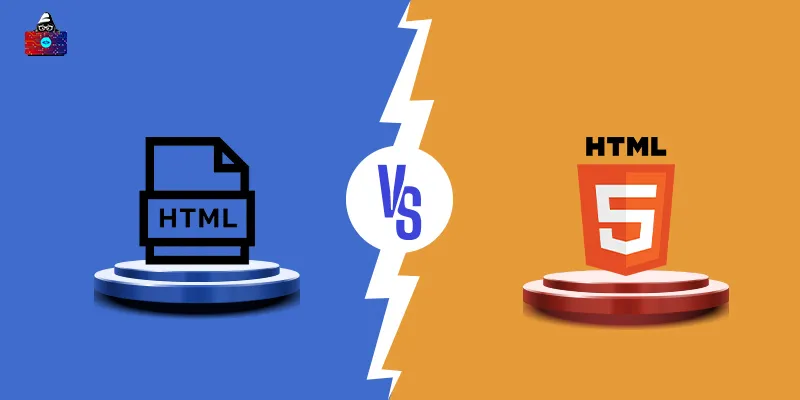Every beginner who wants to pursue a career in web development needs to start with front-end web development. In front-end development, we use several terms, like HTML, HTML5, CSS, CSS3, and JavaScript. However, most beginners often get confused between certain terms, like CSS and CSS3, HTML and HTML5, etc. Although the terms are somehow related to one another, they are certainly not the same thing. And this gives rise to certain comparisons, including HTML vs HTML5 and CSS vs CSS3.
Here in this article, we will compare HTML and HTML5 to highlight the differences between them. But before moving on to discuss HTML vs HTML5, let's have a brief explanation of both the terms individually.
HTML vs HTML5: Definition
What is HTML?
In 1993, HTML came into existence. It was created by Tim Berners-Lee who is also known as the father of the World Wide Web. HTML stands for HyperText Markup Language, and it is the standard markup language used to build web pages. For a better explanation of HTML, we have to split HTML into two parts, that is, hypertext and markup . Hypertext refers to the technique by which we render the text models using hyperlinks. As HTML pages are static by nature and only able to show black and white text, we need to use style sheet languages and scripting languages along with HTML to make web pages dynamic and attractive.
On the other hand, a markup deals with the tags that we use in HTML. They give formatting to the HTML text content and also provide some features to the HTML pages. Markup provides tags in HTML that are used to insert images and hyperlinks and even change the formatting of the HTML text . HTML is considered the backbone of the World Wide Web because everything that we get displayed on the internet is basically HTML pages. Browsers like Google Chrome and Internet Explorer are the platforms that can run the HTML code.
What is HTML5?
HTML5 was first introduced in 2014, and in simple words, HTML5 is the latest version of HTML itself. Ever since HTML was introduced, its developers have been putting efforts into its further development. Before HTML5, we had HTML4 and HTML3, but there was no hype about HTML up-gradation, and developers did not use the terms HTML4 or HTML3; instead, they preferred to call them HTML as well. But with the introduction of HTML5, everything changed.
In 2014, when developers introduced HTML5 with new features, which include some dynamic features too, instead of referring to it as HTML, they started calling it HTML5. HTML5 is capable of performing some tasks that earlier required JavaScript code. Also, W3C has introduced many APIs in HTML5. Today, almost all modern browsers can run HTML5 files.
HTML vs HTML5: Head to Head Comparison
| HTML | HTML5 |
|
Explanation |
|
| HTML is a markup language that helps to create the structure of web pages and add various elements to them, such as text and images. | HTML5 is the latest version of HTML and it is also a markup language. |
|
Multimedia |
|
| HTML does not support video and audio files. | HTML5 allows the insertion of audio as well as video files in web pages. |
|
Geographical Location |
|
| HTML did not have any support for geographical location. HTML would use JavaScript for getting a user's geographical location. | HTML5 comes with the geographical location feature, which means that HTML5 itself is able to retrieve a user's geographical location. |
|
Storage |
|
| HTML only uses cookies to store temporary data. | HTML5 uses a SQL database and cache to store data. |
|
Vector Graphics |
|
| HTML uses third-party technologies such as VML, flash, server light, etc. to support vector graphics . | HTML5 comes with inbuilt support for vector graphics, like SVG and canvas. |
|
Drag and Drop Effect |
|
| HTML does not support simple drag and drop. | HTML5 supports the drag and drop effect. |
|
Mobile Support |
|
| HTML is not mobile-friendly. | HTML5 is mobile-friendly. |
|
New Elements |
|
| HTML did not have elements like nav and header. | HTML5 comes with nav and header elements. |
|
Socket Support |
|
| HTML did not have socket support. All the communication between client and server is done through streaming. | In HTML5, we have web socket support, which creates a full-duplex communication between client and server. |
|
Error Handling |
|
| HTML is unable to handle inaccurate syntax or any other errors. | HTML5 can handle many errors pretty well. |
|
Threading |
|
| In HTML, JavaScript run within the same thread as the browser interface. | In HTML5, we have a web worker API for running JavaScript code. |
Conclusion
Most websites that you see today are created using HTML5. Now every browser comes with the support for HTML5 and treats all HTML files as HTML5 files. You do not have to be confused with the terms HTML and HTML5 as both have the same utility, but HTML5 is the latest version of HTML.
People are also reading:





Leave a Comment on this Post